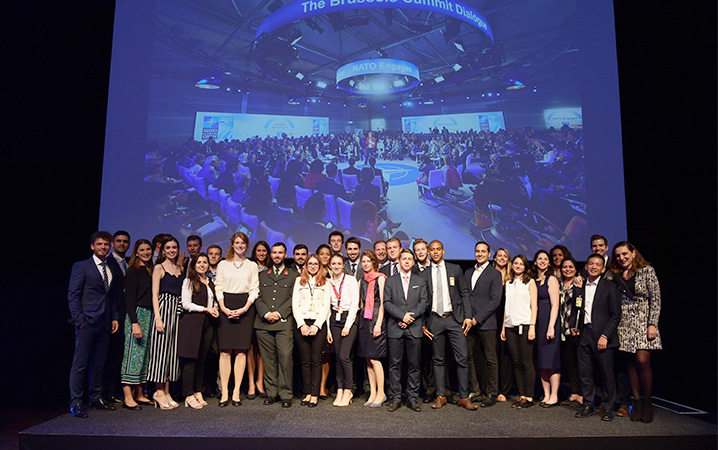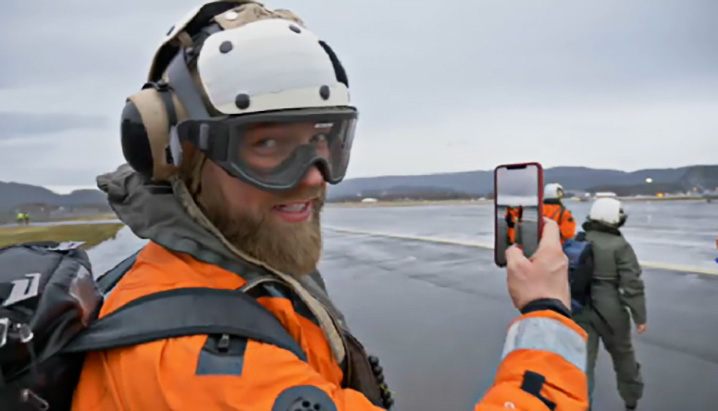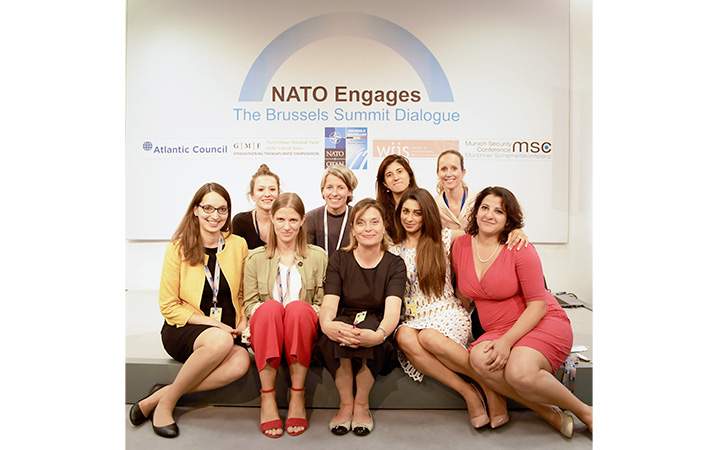Disinformation is nothing new but today – thanks to social media – malign actors, both foreign and domestic, are able to manipulate the truth and reach millions of people at the click of a button. Such tactics distort information, dismiss critics, distract from the real issues and dismay audiences with a view to undermining societal resilience. It is essential to counter this hybrid threat by educating and preparing the publics of the transatlantic community – especially younger audiences.
With Allies celebrating NATO’s 70th anniversary and underlining its continued relevance in the face of a broad range of security challenges, this year offers a good opportunity to stimulate greater youth interest in defence and security matters. A promising start was made at the first ‘NATO Engages’ event, held on the margins of the NATO Summit in July 2018. It experimented with a new format of engagement, and 35 per cent of participants from across the transatlantic sphere were under 35 (I attended as a “Future Leader”). Youth were also a focus of the second iteration of ‘NATO Engages’, which took place in Washington in April to mark NATOs 70th anniversary. Moreover, the third iteration, due to take place at the upcoming meeting of NATO leaders in London in December, aims to raise youth participation to 50 per cent.

The first ‘NATO Engages’ event, held on the margins of the NATO Summit in July 2018, experimented with a new format of engagement and 35 per cent of participants from across the transatlantic sphere were under 35. © NATO
Despite these promising initiatives, more could be done to meet youth expectations, as well as increase awareness and encourage involvement in contributing to transatlantic security. A more youth-oriented engagement process that is lifestyle friendly could be designed to offer professional empowerment chances and social opportunities to cultivate a personal connection with defence and security material. Only by encouraging ownership and incentivising participation in the field, will the youth of today take a serious interest in these matters tomorrow.
Although media savvy and hyperconnected, millennials and Generation Z (i.e. the generation reaching adulthood in the second decade of the 21st century) are generally not well informed on issues related to defence and security. Too young to recall the existential threat of nuclear weapons during the Cold War, the horrors of the Yugoslav Wars, their introduction to security matters has primarily been shaped by the aftermath of the terror attacks on the United States on 9/11, which led to the military intervention in Afghanistan, as well as by the more recent rise of ISIS/Daesh.
Today’s security challenges bear little resemblance to those of the past. Although some features have re-emerged, such as great power rivalries and the deterrence value of nuclear weapons, the introduction of non-state actors and hybrid warfare is reconfiguring the global security architecture. Yet, one constant remains: at its most basic level, security is an inclusive topic which can bring together diverse groups of people to work together to ensure safety and stability. This concept is a powerful engagement tool and an opportunity that should not be squandered.
Inserting security in the mainstream
Current security issues need to occupy more space in the mainstream media domain as well as on social media channels. Countless global examples justify its heightened visibility and political leaders on all levels of government across the transatlantic sphere could do more to promote them. Although this will not materialise overnight, elevating the status of defence and security topics could gradually filter into social media newsfeeds, getting them onto the young people’s radar.
To help accomplish this, NATO and individual Allies could boost efforts in their communications to feature more young people and civilian roles in security and defence as well as present a more human face of the Alliance. This would balance more traditional images of troops and equipment (sometimes referred to as “military porn” or “milporn” which tends to appeal to some, mainly male, young people but can be a turn-off to others).
The #WeAreNATO video profile of Norwegian female tank commander Lt. Silje Johansen Willassen as part of the enhanced Forward Presence in Lithuania is a great example of fusing hard power imagery with a positive message of female empowerment that resonates with a larger audience. The effectiveness of using a young spokesperson to engage young people on social media with content about NATO and its operations was demonstrated by Norwegian Lt. Lasse Løkken Matberg, whose coverage of Trident Juncture 2018 – NATO’s largest exercise since the end of the Cold War – on his Instagram account went viral. Other good examples of content that successfully humanises NATO are images that capture moments of comradery between Allies, such as Latvia’s Armed Forces playing ice hockey with Canadians troops deployed as part of NATO’s enhanced Forward Presence (eFP), or members of the Canadian eFP detachment participating in the multinational Nijmegen marches annual event in the Netherlands.

Lasse Løkken Matberg is a young lieutenant in the Royal Norwegian Navy, whose coverage of NATO Exercise Trident Juncture 2018 on his Instagram account went viral. © NATO
Engagement should also seek to strike a balance between traditional defence and security issues, and the priorities of younger audiences. The youth of today are not living under the fear impending of nuclear strikes and in particular youth in the western part of the alliance (US, Canada, Western Europe) ascribe less value to hard security issues compared to baby boomers (i.e. the generation born between 1946 and 1964).
Consider the survey outcomes of American respondents worried about national security issues as found in the Security 2040 initiative by the Rand Corporation. On the issue of North Korea’s nuclear programme, 82.7 per cent of baby boomers assessed it as a major threat, compared to only 63.5 per cent of millennials. The same polling trend extends to the issue of the perceived threat by Islamic extremist groups, such as Al Qaeda or ISIS/Daesh, which 80.1 per cent of baby boomers considered a threat compared to only 64.5 per cent of millennials. The findings of the overall survey suggest that the general public in the United States, especially millennials, prioritise the allocation of resources towards domestic-related security issues as opposed to foreign policy issues.
The international success of the ‘Fridays for Future’ movement of school students, who are cutting classes to take part in demonstrations to demand action to prevent further global warming, shows that many young people consider this to be the most important threat facing them. This supports the argument for strengthening efforts to integrate more content devoted to softer security issues like environmental preservation, disaster-relief operations and humanitarian assistance, with a view to engaging more young audiences.
Of course, one should not overgeneralise – young people are not one monolithic body and a nuanced approach is required. Threat perceptions and views on geopolitical issues vary among audiences in different parts of the Alliance. Young people in the Baltic States, for example, are clearly more likely to be interested in hard security issues and to see the value of NATO in the current security environment, than their peers elsewhere.
Attracting new stakeholders
In concert with this, youth engagement needs to cast a wider net to diversify a new set of stakeholders. An emphasis on recruiting women should underscore this engagement process to help promote greater gender parity throughout the transatlantic security and defence domain. Deepening consultations with Women in International Security (WIIS) as well as Brussels Binder could provide valuable guidance on how effectively to engage qualified female professionals.

Defence and security have traditionally been perceived as a male domain. It is important for NATO to reach out to women, including through Women in International Security (WIIS). © NATO
Traditionally, engagement efforts have focused on attracting and retaining millennials and Gen Z individuals, who have already demonstrated an interest in defence and security matters. Although exclusively engaging this segment will secure a source of individuals with a long-term interest in the subject matter, it runs the risk of discouraging youth with backgrounds in fields like science or business from involving themselves in security and defence affairs due to its perceived elitist nature. For this reason, the engagement process needs to concentrate on building a series of new ecosystems and increasing the talent pool.
For example, as young bankers in London conduct much of their business based on the global financial markets, they have a material interest in understanding the current international security dynamic and how it might impact either the movement of commodities like energy, as well as the trading of goods. The same interest in security affairs can be extended to entrepreneurs and European start-up companies, who should know the emerging threats posed by state and non-state actors who could potentially compromise their networks, logistics and cloud computing systems. Consequently, adopting a more comprehensive engagement process could help increase awareness and support for the Alliance, and even act as a more effective recruitment tool.
When it comes to engaging with a youth-based audience in a physical setting, it is worth considering organising and supporting more events where young professionals or experts are deployed to talk about security and defence issues. They may find it easier to connect with millennials and Gen Z and can serve as role models for involvement in this sphere. That is not to say that former ambassadors and retired senior military personnel do not have an important role to play in the engagement process. But, instead of being the focal point of this process, their status might be more effective if repurposed in a complementary role. This concept was on display at the last ‘NATO Engages’ in Washington, where Karlijn Jans, a former GLOBSEC Young Leaders Forum (GYLF) member and now Defence Policy Advisor at the British Embassy in the Hague shared the stage with the former Commander of the United States Army in Europe, the Latvian foreign minister and the Chairman of the Munich Security Conference.
Building connections and solving problems
The circuit of security and defense conferences throughout Europe and North America, which seek to integrate a young professional component, would do well to consider elevating the role of young people by offering them more opportunities to make meaningful contributions. This includes having them act as a moderator or speaker, or at least allocating a time slot during the Q&A. Some organisations (e.g. the Atlantic Council of the United States, the Atlantic Forum, the German Marshall Fund, GLOBSEC and Young Professionals in Foreign Policy) understand this well and seek to cultivate better youth-to-youth outreach. For instance, the GLOBSEC 2019 Bratislava Forum successfully put youth at the forefront by asking select participants at the GYLF to prepare a short policy response to the 2018 NATO Secretary General’s Annual Report, which was presented to the audience prior to the keynote speech of Admiral Manfred Nielson, Deputy Supreme Allied Commander Transformation. Furthermore, all GYLFs were invited to participate in a private Q&A session with the Admiral, whose commitment to generate youth interest in NATO has been stated on multiple occasions: “If I could, I would replace 30 per cent of my staff with young people under 30.”
Finally, the youth engagement process should not underestimate the intellectual appeal of solving big problems. Many of today’s youth are big dreamers and want to be part of something larger for the greater good. Offering a security and defence outlet that serves their intellectual appetite could incentivise their participation and raise their willingness to take ownership of the solution. The organisation of an “innovation challenge” in 2018 by Allied Command Transformation, where ten start-ups and smaller firms presented ideas for defeating swarms of drones on the ground and in the air, is a concept that could be replicated and offered more frequently by various NATO headquarters and Centres of Excellence. With the groundswell of complex security issues facing the transatlantic community, organising a case competition with real policy implications might help uncover a previously overlooked solution to a major issue.
Increasing the ‘likes’ for defence and security issues among the youth is an exercise in patience. Nevertheless, improving the engagement process represents an opportunity to connect with and potentially prepare millennials and Gen Z on issues of transatlantic security, like disinformation, and help ensure they are an asset and not liability when facing threatening activity.
